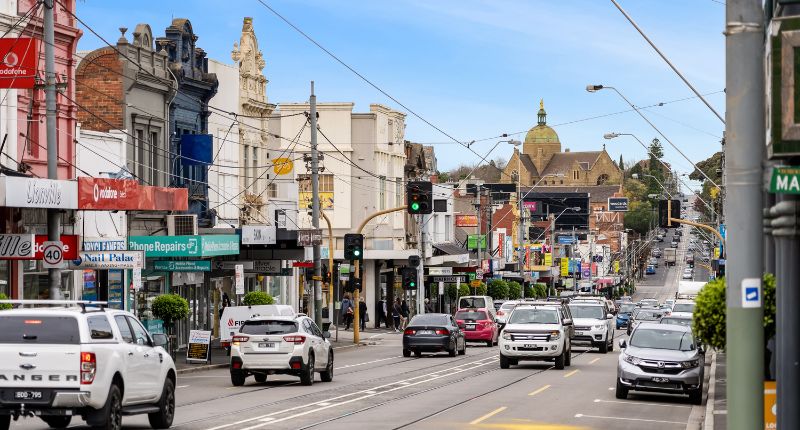- Vacancy rates hit the long-term low in 2022.
- Melburnian shopping strips took a major hit through Covid, reaching a high of 10.3%.
- The latest vacancy rate is 1.5ppt below the long-term average.
Chapel Street, Lygon Street, and other famous Melburnian shopping strips are enjoying a strong post-Covid recovery and are performing admirably despite economic headwinds.
Vacancy rates for Melbourne’s shopping strips have now gone below long-term lows, according to Fitzroys‘ latest Walk the Strip report, released earlier today.
Vacancies for Melburnian shopping strips dropped over the past 12 months, despite already reaching a long-term low in 2022. Melbourne retail strip vacancy rates fell by another 0.5% to an overall average of 6.2%, which is 1.5 percentage points below the long-term average of 7.7%; vacancy rates hit a high of 10.3% in 2021.
“Working-from-home and flexible working arrangements have created a fundamental shift in Melburnians’ relationship with their shopping strips,” said Fitzroys division director, James Lockwood.
“We are spending more money closer to home and spending more time at our local villages than ever.
“This hyperlocality has evidently offset some of the impact of a consumer spending slowdown, as high inflation and rising interest rates affect people’s spending habits.”
James Lockwood, Fitzroys
Lockwood added that while inflation and interest rates have led to many tightening their purse strings, working from home is here to stay, meaning a great deal of spending will still be concentrated on the shopping strips.
“Non-essential spending may continue to be affected, but there’s still a conversation about how people feel good about themselves – that might be people turning the heater off while they head out for a coffee, treating themselves to a haircut or manicure, or taking that yoga or Pilates class,” Lockwood added.
The retail strip winners
- Speciality retail now comprises 33.4% of all shops along shopping strips. These include fashion, clothing and footwear, bridal, and jewellery.
- Almost three in four (72%) of shopping strips recorded an increase in specialty retail.
- Service retail is now above its long-term average, comprising 27.9% of shops.
- 64% of strips saw an increase in service retail.
However, food and beverage recorded a fall to 30.3%. Despite the reduction, the sector remained just above its long-term average.
Landlords are meeting the market
Church Street in Brighton has recorded a vacancy rate of 1.1%, the lowest in Melbourne. Second place was Hampton Street in Hampton, recording a vacancy rate of 1.8%. Armadale’s High Street also put in an admirable performance at 2.3%. Lygon Street, in Carlton, saw vacancies drop to 6%, having surged to 20% during Covid.
The specialty retail rebound saw Chapel Street, South Yarra vacancies improve from 10.7% to 7.9% – the first time in years the strip has recorded single-digit vacancies.

Lockwood said landlords increasingly meeting the market has helped facilitate deals and fill spaces.
“They’ve been more open to transact, more willing to do a deal. It’s likely they were conditioned during the turbulence of the past few years. Landlords and tenants are definitely now more closely aligned when it comes to rents,” said Lockwood.
Leasing profiles have also changed over the past year, with Lockwood observing more three to five year deals, following shorter-term leases sought during Covid.
“Tenants are clearly showing more confidence going forward and signing longer-term leases,” Lockwood added.
Returning to pre-Covid levels
Lockwood observed that service retail is back, with close contact concerns having gradually subsided. This was of particular benefit to nail salons, skin care clinics, and wellness studios.
“We’ve seen enquiry in the health and fitness space move away from 24-hour gyms and towards wellness studios with personal training approaches, as well as yoga and Pilates offerings,” he said.

Meanwhile, specialty retail and food and beverage have realigned with their long-term averages. Leasing activity in Melbourne’s shopping strips during Covid was dominated by food and beverage operators, who were quickly snapping up fitted-out spaces to service the surging demand for nearby food and delivery services as Melbourne jumped in and out of lockdowns.
“The pandemic and its effects on our consumption patterns coincided with the increase in development across Melbourne’s shopping strips, which our data shows has been elevated since 2020,” said Lockwood.
“We expect this to remain elevated. While a number of people made the treechange and seachange move during Covid, Melbourne’s population is again on the growth path and we’re again seeing people wanting to live, work and play in and around Melbourne’s retail and lifestyle strips.
“As well as bringing new retail offerings to the strip, new developments are bringing more residents and office workers to the immediacy of the strip, boosting the immediate catchment and supporting trade throughout all hours of the day – especially when so many are working from home.”








